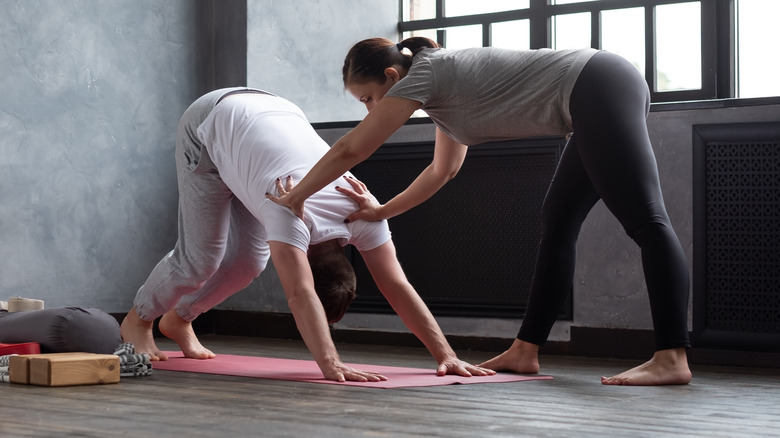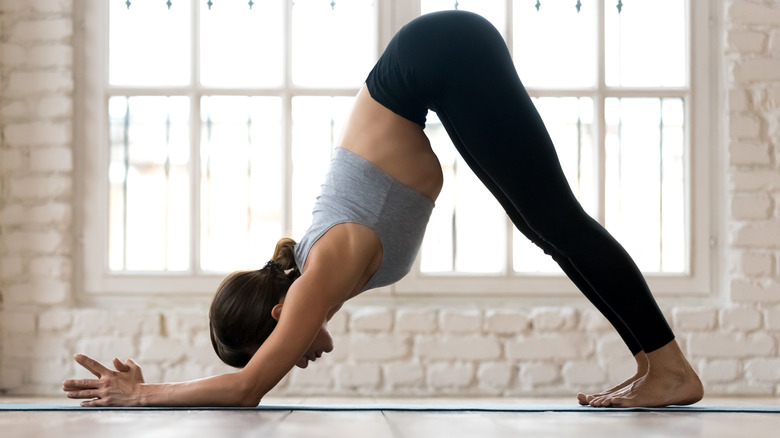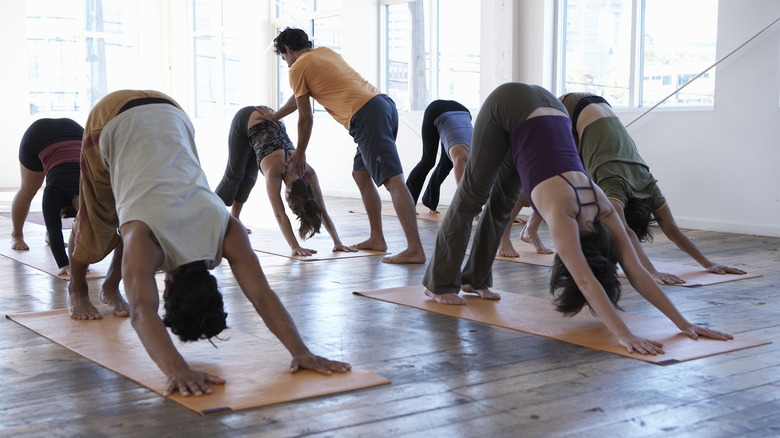Ways To Modify Downward Facing Dog Pose In Yoga
One of the most common poses you'll encounter in a yoga class is downward-facing dog. You'll do one if your instructor says, "Take a vinyasa." It's also seen as a resting pose after a hard sequence. But downward-facing dog isn't for everyone, especially for beginners, according to YogaU Online. If your feet are at an awkward angle, you could be putting too much strain on your ankles and knees. According to Yoga Anatomy, downward-facing dog could easily create a shoulder impingement when your lats press down and internally rotate your shoulders. If your forearms aren't active in downward-facing dog, you could also put too much pressure on your elbows and wrists.
The Living Well Institute says downward-facing dog involves a lot of muscular strength and endurance and mobility in the lower back and pelvis. Because there is so much room for error in the pose, over time, doing it can lead to injury if you're not using proper form. Think of it this way, favoring one foot while you're standing might not be noticeable for a while, but it could lead to an imbalance in the future if you're not careful.
You should avoid downward-facing dog if you have high blood pressure or you're pregnant (via The New York Times). If you have a wrist injury (related to yoga or not), downward dog might not feel very good. If your instructor calls for a downward-facing dog and you'd like to perform a less intense version, here are some ways to modify the pose.
Downward dog modifications
Sometimes downward dog might feel great after certain difficult postures because it helps neutralize the spine, according to Yoga Jala. If it feels painful, you can modify it according to your needs. If your wrists are feeling a pinch, you can fold a yoga strap a few times (or use a folded towel) and place it underneath the heels of your hands. That puts more of the work on your forearms, which should be engaged in downward dog. You can also give your wrists a break in downward-facing dog by coming into dolphin pose, which is a downward dog with your forearms on the mat.
If you feel downward-facing dog is too taxing on your tight shoulders, open your hand position so that your left hand faces 11:00 and your right hand points to 1:00. It also helps to place your hands wider, almost to the width of your mat. You can give your shoulders a beautiful stretch by practicing puppy pose, which is downward dog with your knees on the mat and your hips lifted above or forward of your knees.
Downward facing dog can also challenge your upper body strength. If this is the case, check the distance between your hands and feet. The longer the stance, the more your upper body has to work, so try shortening your stance to reduce the intensity.
How to do downward-facing dog pose
If you're new to yoga and your instructor hasn't quite explained the details of downward-facing dog pose, here's a quick set of cues to remember. Downward dog shouldn't be a hybrid plank pose where there's a bend at your shoulders, according to Yoga Jala. Instead, think of the pose as an inverted V. Your lower back and hamstrings might not have the flexibility (yet) to allow your pelvis to tilt forward, so bend your knees until the pose feels comfortable, according to Yoga Journal. Many people won't be able to get their heels down, and that's ok. If it's more comfortable for you, feel free to roll up the edge of your mat to place under your heels.
Downward-facing dog can get kinda tricky with your arms and hands. To engage your forearms, press the knuckles of your index finger into the mat. Your forearms and hands should be rotating inward while your shoulders have a slight external rotation. You'll engage your triceps as you straighten your elbows and press the mat away from you. Avoid locking your elbows, and keep your upper arms and ears in one line.



